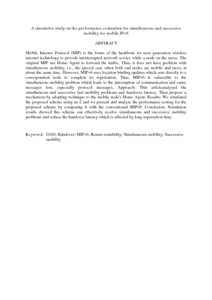Citation
Abdullah, Ibrahim and Othman, Mohamed
(2010)
A simulative study on the performance evaluation for simultaneous and successive mobility for mobile IPv6.
Journal of Computer Science, 6 (12).
pp. 1511-1517.
ISSN 1549-3636
Abstract
Mobile Internet Protocol (MIP) is the forms of the backbone for next generation wireless internet technology to provide uninterrupted network service while a node on the move. The original MIP use Home Agent to forward the traffic. Thus, it does not have problem with simultaneous mobility, i.e., the special case when both end nodes are mobile and move at about the same time. However, MIPv6 uses location binding updates which sent directly to a correspondent node to complete its registration. Thus, MIPv6 is vulnerable to the simultaneous mobility problem which leads to the interruption of communication and cause messages lost, especially protocol messages. Approach: This articleanalyzed the simultaneous and successive fast mobility problems and handover latency. Then propose a mechanism by adopting technique to the mobile node's Home Agent. Results: We simulated the proposed scheme using ns-2 and we present and analyze the performance testing for the proposed scheme by comparing it with the conventional MIPv6. Conclusion: Simulation results showed this scheme can effectively resolve simultaneous and successive mobility problems and reduce the handover latency which is affected by long registration time.
Download File
![[img]](http://psasir.upm.edu.my/12863/1.hassmallThumbnailVersion/A%20simulative%20study%20on%20the%20performance%20evaluation%20for%20simultaneous%20and%20successive%20mobility%20for%20mobile%20IPv6.pdf)  Preview |
|
PDF (Abstract)
A simulative study on the performance evaluation for simultaneous and successive mobility for mobile IPv6.pdf
Download (85kB)
| Preview
|
|
Additional Metadata
Actions (login required)
 |
View Item |

